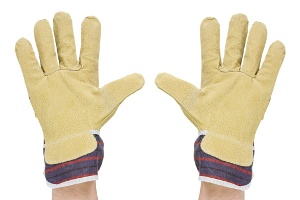 Skin contact is a potential source of exposure to toxic materials; it is important that the proper steps be taken to prevent such contact.
Skin contact is a potential source of exposure to toxic materials; it is important that the proper steps be taken to prevent such contact.
Most accidents involving hands and arms can be classified under four main hazard categories: chemicals, abrasions, cutting, and heat. There are gloves available that can protect workers from any of these individual hazards or any combination thereof.
Gloves should be replaced periodically, depending on frequency of use and permeability to the substance(s) handled. Gloves overtly contaminated should be rinsed and then carefully removed after use.
Gloves should also be worn whenever it is necessary to handle rough or sharp-edged objects, and very hot or very cold materials. The type of glove materials to be used in these situations include leather, welder’s gloves, aluminum-backed gloves, and other types of insulated glove materials.
Careful attention must be given to protecting your hands when working with tools and machinery. Power tools and machinery must have guards installed or incorporated into their design that prevent the hands from contacting the point of operation, power train, or other moving parts. To protect hands from injury due to contact with moving parts, it is important to:
- Ensure that guards are always in place and used.
- Always lock-out machines or tools and disconnect the power before making repairs.
- Treat a machine without a guard as inoperative; and
- Do not wear gloves around moving machinery, such as drill presses, mills, lathes, and grinders.
The following is a guide to the most common types of protective work gloves and the types of hazards they can guard against:
- Disposable Gloves. Disposable gloves, usually made of light-weight plastic, can help guard against mild irritants.
- Fabric Gloves. Made of cotton or fabric blends are generally used to improve grip when handling slippery objects. They also help insulate hands from mild heat or cold.
- Leather Gloves. These gloves are used to guard against injuries from sparks or scraping against rough surfaces. They are also used in combination with an insulated liner when working with electricity.
- Metal Mesh Gloves. These gloves are used to protect hands form accidental cuts and scratches. They are used most commonly by persons working with cutting tools or other sharp instruments.
- Aluminized Gloves. Gloves made of aluminized fabric are designed to insulate hands from intense heat. These gloves are most commonly used by persons working molten materials.
- Chemical Resistance Gloves. These gloves may be made of rubber, neoprene, polyvinyl alcohol or vinyl, etc. The gloves protect hands from corrosives, oils, and solvents. The following table is provided as a guide to the different types of glove materials and the chemicals they can be used against. When selecting chemical resistance gloves, be sure to consult the manufacturers’ recommendations, especially if the gloved hand will be immersed in the chemical.
Source: Argonne National Laboratory www.aps.anl.gov

